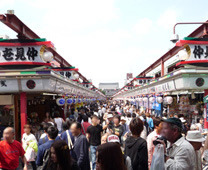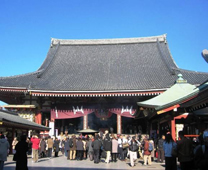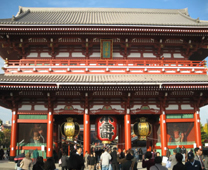
Travel Guide
Introduction
Founded in 628, Sensoji Temple is the oldest and most popular temple in Tokyo. Formerly associated with the Tendai sect of Buddhism, it became independent after World War II. Many people believe that the Asakusa Kannon deity enshrined here has the ability to bestow benefits on earth, and around 30 million visitors from throughout Japan and abroad visit the temple every year. It was the epicenter for the development of Edo culture, and these traces still remain today. Many seasonal events are held including the Hozuki (Chinese lantern plant) Market and Hagoita (wooden paddle) Market. The huge lanterns hung at Kaminarimon (Thunder) Gate are very famous throughout Japan.
Temple complex
Dominating the entrance to the temple is the Kaminarimon or "Thunder Gate". It was originally built in 942 by military commander Taira no Kinmasa. This imposing Buddhist structure features a massive paper lantern dramatically painted in vivid red-and-black tones to suggest thunderclouds and lightning. Kaminarimon contains two protective deities - (left side) Raijin - God of Thunder and (right side) Fujin - God of Wind. Beyond the Kaminarimon is Nakamise-dori with its shops, followed by the Hozomon or "Treasure House Gate" which provides the entrance to the inner complex.
The Nakamise-dori, or Nakamise Avenue, is a shopping street of over 200 meters, which leads from the outer gate to the temple's second gate, the Hozomon. Alongside typical Japanese souvenirs such as yukata and folding fans, various traditional local snacks from the Asakusa area are sold along the Nakamise-dori. A must try here are the famous sembei (rice crackers).
It is said Nakamise-dori to have come about in the early 18th century, when neighbors of Sensoji Temple were granted permission to set up shops on the approach to the temple. However, in May 1885 the government of Tokyo ordered all shop owners to leave. In December of that same year the area was reconstructed in Western-style brick. During the 1923 Great Kanto earthquake many of the shops were destroyed, then rebuilt in 1925 using concrete, only to be destroyed again during the bombings of World War II.
The Hozomon Gate is the gateway to the inner complex of Sensoji Temple and the temple’s inner gate. The second floor of the Hozomon Gate houses many of Sensoji’s treasures, including a copy of the Lotus Sutra, and the Issai-kyo scriptures. The first floor has two identical statues located on either side of the gate’s south face. They are Nio Guardians, the guardian deity of Buddha, and the gate was originally known as the Niomon. The first floor also features three large lanterns, and two large straw sandals called waraji. They were crafted by villagers in northern Yamagata Prefecture, and are meant to symbolize the Buddha’s power. It is believed that evil spirits will be scared off by the giant sandals. The Hozomon Gate was originally built in 942 AD with the present structure a 1964 reconstruction.
Beyond the Hozomon Gate stands the temple's main hall and a five storied pagoda which is said to contain some of the ashes of Buddha. The Pagoda is approximately 53 meters high and is especially picturesque at night when all lit up. The original was built in 942 with the current structure is a 1973 reconstruction. It is a national treasure and the second highest pagoda in Japan.
The Hondo (Main Hall) houses the Kannon image, which is away from view deep inside the hall. It is a national treasure and was originally built in 942, but later rebuilt by the third Shogun, Tokugawa Iemitsu. The Kannon image is never shown to the public. The current building dates from 1958. A key feature of the Main Hall is its distinctive sloping roof that is quite tall, allowing it to be seen from a great distance.
Asakusa Shrine is a Shinto shrine next to the Sensoji Temple. It is dedicated to the three men who established Sensoji Temple. Two of them are the fishermen who found a statue of the bosatsu Kannon in the Sumida River. The third, the village headman, Haji no Nakatomo, built Sensoji Temple.
Within the temple itself, and also at many places on its approach, there are o-mikuji stalls. For a suggested donation of 100 yen, visitors may consult the oracle and divine answers to their questions. Querents shake labelled sticks from enclosed metal containers and read the corresponding answers they retrieve from one of 100 possible drawers.
Within the temple is a quiet contemplative garden kept in the distinctive Japanese style.
History
The temple is dedicated to the bodhisattva Kannon (Avalokiteśvara). According to legend, a statue of the Kannon, the goddess of mercy, was found in the Sumida River in 628 by two fishermen, the brothers Hinokuma Hamanari and Hinokuma Takenari. Even though they put the statue back into the river, it always returned to them. The chief of their village, Hajino Nakamoto, recognized the sanctity of the statue and enshrined it by remodeling his own house into a small temple in Asakusa so that the villagers could worship Kannon. The temple was completed in 645, making it Tokyo's oldest temple.
In the early years of the Tokugawa shogunate, Tokugawa Ieyasu designated Sensoji Temple as tutelary temple of the Tokugawa clan.
During World War II, the temple was bombed and destroyed. It was rebuilt later and is a symbol of rebirth and peace to the Japanese people. In the courtyard there is a tree that was hit by a bomb in the air raids, and it had regrown in the husk of the old tree and is a similar symbol to the temple itself.
 |
 |
 |
| Nakamise-dori | Hondo (main hall) | Hozomon Gate |
Travel Advice
Sightseeing
- Asakusa is famous for ningyo yaki. This snack is batter that is fried inside an intricate mold, such as a fish, an animal, or a Hello Kitty face. While typically filled with anko red bean paste, ningyo yaki in Asakusa is something filled with chocolate or custard cream. Tempura, Monjyayaki (Japanese pan-fried batter) and many more local specialties in Asakusa are available.
- Asakusa is a temple town, which flourished during Edo period and is one of the most popular tourist spots in Tokyo. The atmosphere of old Japan attracts many tourists throughout the year. Especially, many people visit Asakusa during New Year's holidays and various festivals.
- Asakusa can easily be explored on foot. Alternatively, you can consider a guided tour on a rickshaw (jinrikisha, literally "man powered vehicle") which is one of the famous attractions in Asakusa. A 30 minute tour for two persons costs around 8000 yen. Shorter and longer courses are also available.
Three great Shinto festivals are Sanja Matsuri of Sensoji Temple, Sanno Matsuri of Hiejinja Temple and Kanda Matsuri of Kandajinja Temple.
Events
| Events in 2020 | ||
| Sanja Matsuri | Nearly 2 million people join the festival. About one hundred mikoshi and portable shrines parade streets. During the festival, Asakusa is packed with food stalls, festival games and revelers amid a lively atmosphere of Japanese drums and flutes. | Oct 16(Fri)~ 18(Sun) |
Visit
| Address | 2-3-1 Asakusa, Taito-ku, Tokyo | |
| Phone | 03-3842-0181 | |
| Admission | Free | |
| Hours | Temple grounds Free Temple buildings 06:00 to 17:00 (October to March 06:30 to 17:00)。 |
|
| Closed | Open 7 Days a Week | |
| Duration | 30 minutes | |
| Getting There | By Train 5 minutes walk from Asakusa Station on Isezaki Line. 5 minutes walk from Asakusa Station on subway Ginza Line. 5 minutes walk from Asakusa Station on Tsukuba Express Line. 7 minutes walk from Asakusa Station on subway Asakusa Line. By Car Take Shuto Expressway to the Ueno exit or Komagata exit. It is approximately 10 minutes from exit. |
|
| Parking | No parking available | |

